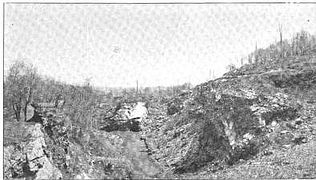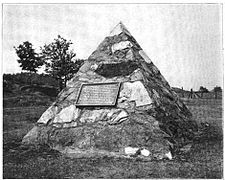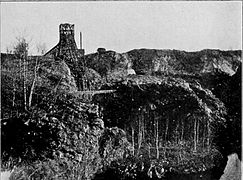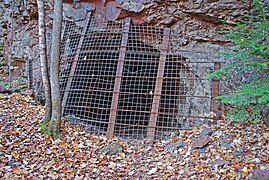
Marquette ( mar-KEHT) is a city in Marquette County in the U.S. state of Michigan. The population was 20,629 at the 2020 United States Census, which makes it the largest city in the Upper Peninsula. It also serves as the county seat of Marquette County. Located on the shores of Lake Superior, the city is a major port, known primarily for shipping iron ore. The city is partially surrounded by Marquette Charter Township, but the two are administered autonomously.
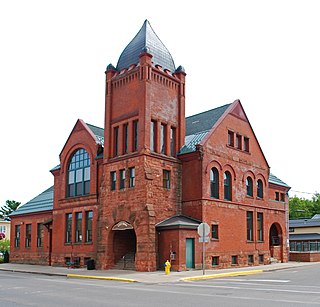
Ishpeming is a city in Marquette County in the Upper Peninsula of the U.S. state of Michigan. The population was 6,470 at the 2010 census, less than it was in the 1950s and 1960s when the iron ore mines employed more workers. A statue of a Native American figure, erected in 1884 in the small town square, is referred to as "Old Ish".

Negaunee is a city in Marquette County in the U.S. state of Michigan. The population was 4,568 at the 2010 census. The city is located at the southwest corner of Negaunee Township, which is administratively separate, in the Upper Peninsula. The city is home to a luge track. The name Negaunee comes from an Anishinabemowin (Ojibwa) word nigani, meaning "foremost, in advance, leading," which was determined to be the closest Ojibwa translation for "pioneer". Within the city limits is Teal Lake.

The term Iron Range refers collectively or individually to a number of elongated iron-ore mining districts around Lake Superior in the United States and Canada. Despite the word "range", the iron ranges are not mountain chains, but outcrops of Precambrian sedimentary formations containing high percentages of iron. These cherty iron ore deposits are Precambrian in age for the Vermilion Range and middle Precambrian in age for the Mesabi and Cuyuna ranges, all in Minnesota. The Gogebic Range in Wisconsin and the Marquette Iron Range and Menominee Range in Michigan have similar characteristics and are of similar age. Natural ores and concentrates were produced from 1848 until the mid 1950s, when taconites and jaspers were concentrated and pelletized, and started to become the major source of iron production.
M-35 is a state trunkline highway in the Upper Peninsula (UP) of the US state of Michigan. It runs for 128 miles (206 km) in a general north–south direction and connects the cities of Menominee, Escanaba, and Negaunee. The southern section of M-35 in Menominee and Delta counties carries two additional designations; M-35 forms a segment of the Lake Michigan Circle Tour, and it is the UP Hidden Coast Recreational Heritage Trail, which is a part of what is now called the Pure Michigan Byways Program. Along the southern section, the highway is the closest trunkline to the Green Bay, a section of Lake Michigan. The northern section of the highway turns inland through sylvan areas of the UP, connecting rural portions of Delta and Marquette counties.
Business M-28 is a state trunkline highway serving as a business route that runs for 4.841 miles (7.791 km) through the downtown districts of Ishpeming and Negaunee in the US state of Michigan. The trunkline provides a marked route for traffic diverting from U.S. Highway 41 (US 41) and M-28 through the two historic iron-mining communities. It is one of three business loops for M-numbered highways in the state of Michigan. There have previously been two other Bus. M-28 designations for highways in Newberry and Marquette.

The Lake Superior and Ishpeming Railroad, a U.S. railroad offering service from Marquette, Michigan, to nearby locations in Michigan's Upper Peninsula, began operations in 1896. The LS&I continues to operate as an independent railroad from its headquarters in Marquette.

The Cliffs Shaft Mine Museum is a former iron mine, now a heritage museum, located on Euclid Street between Lakeshore Drive and Spruce Street in Ishpeming, Michigan. The museum, operated by "Marquette Range Iron Mining Heritage Theme Park Inc.", celebrates the history of the Marquette Iron Range. The site was designated a state of Michigan historic site in 1973 and placed on the National Register of Historic Places in 1992.

Onota was a village in the Upper Peninsula of the U.S. state of Michigan. It was located on the Grand Island Bay of Lake Superior near the present-day community of Christmas about five miles (8 km) west of Munising in Alger County. The site of Onota is within the Bay Furnace Campground and Picnic Area of the Hiawatha National Forest. The remains of Bay Furnace, a blast furnace used for smelting iron, is the only extant remnant of the town. Bay Furnace was listed on the National Register of Historic Places and designated a Michigan State Historic Site in 1971.
Cleveland-Cliffs Inc., formerly Cliffs Natural Resources, is a Cleveland, Ohio-based company that specializes in the mining, beneficiation, and pelletizing of iron ore, as well as steelmaking, including stamping and tooling. It is the largest flat-rolled steel producer in North America.
County Road 492 is a primary county road in Marquette County, Michigan. The road serves as an alternate route between Negaunee and Marquette. Several historic sites line the roadway as it runs south and parallel to the main highway, U.S. Highway 41 (US 41) and M-28, through the Marquette Iron Range in Michigan's Upper Peninsula. The path of the road runs near tracks of the Lake Superior and Ishpeming Railroad (LS&I). The locally created Iron Ore Heritage Trail will follow CR 492 through Eagle Mills and Morgan Meadows upon completion. The western terminus of the county road is on US 41/M-28 in Negaunee and the eastern end is in Marquette next to Lake Superior.

The Marquette Iron Range is a deposit of iron ore located in Marquette County, Michigan in the United States. The towns of Ishpeming and Negaunee developed as a result of mining this deposit. A smaller counterpart of Minnesota's Mesabi Range, this is one of two iron ranges in the Lake Superior basin that are in active production as of 2018. The iron ore of the Marquette Range has been mined continuously from 1847 until the present day. Marquette Iron Range is the deposit's popular and commercial name; it is also known to geologists as the Negaunee Iron Formation.

The Carp River Forge is an abandoned iron forge located along the Carp River on the grounds of the Michigan Iron Industry Museum, at 73 Forge Road near Negaunee, Michigan. It was the first forge constructed in northern Michigan; the site was designated a Michigan State Historic Site in 1956 and listed on the National Register of Historic Places in 1975. It is also known as the Jackson Iron Company Site.

Peter White was one of the original settlers of Marquette, Michigan. He was a banker, businessman, real estate developer, and a philanthropist; and was involved in a number of the area's iron mining-related businesses, including acting as a director the Cleveland Iron Company. White served in many local and state public offices, including postmaster, county clerk, school board member, state representative and senator, and as a member of the state library commission and a Regent of the University of Michigan. Poet William Henry Drummond said of White, "the trail Peter White has cut through life is blessed by acts of private charity and deeds of public devotion that will serve as a guide to those who follow in the footsteps of a truly great, and above all, good man."

The Schoolcraft Furnace Site is an abandoned iron furnace site located just east of Munising, Michigan within the Pictured Rocks National Lakeshore near the Munising Falls Visitor Center. It was listed on the National Register of Historic Places in 1977. It is also known as the Munising Furnace.

The Cleveland Mine Engine House Number 3, also known as the Brownstone Engine House, is a building located at 601 Division Street in Ishpeming, Michigan. It was built to house engines hoisting ore from various Cleveland Mine locales, and was listed on the National Register of Historic Places in 2007.

Laughing Whitefish is a 1965 historical novel by Justice John D. Voelker, writing under the pen name "Robert Traver". It is based on an actual trilogy of Michigan Supreme Court cases from the 1880s. The final case in the series, Kobogum v. Jackson Iron Co., established in Michigan the general rule that state courts must defer to tribal law in cases involving the internal, domestic relations of American Indians residing within their own territory.

County Road 595 was a proposed primary county road in Marquette County in the US state of Michigan. The road would have provided access from the northern part of the county, near the Eagle Mine in Michigamme Township, to US Highway 41 (US 41) and M-28 in Humboldt Township. The approximately 21.5-mile-long (34.6 km) road would have been used primarily for commercial truck traffic hauling rock from the Eagle Mine to a processing facility south of US 41/M-28 in Humboldt Township. At present, such traffic has to use existing county roads which involves passing through the cities of Marquette, Negaunee, and Ishpeming. The northern end would have been northeast of the mine in Champion Township at an intersection with the Triple A Road.
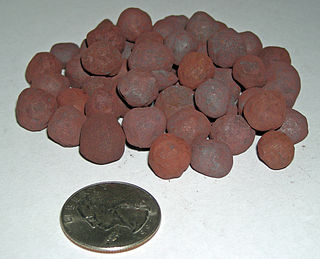
Iron mining in the United States produced 48 million metric tons of iron ore in 2019. Iron ore was the third-highest-value metal mined in the United States, after gold and copper. Iron ore was mined from nine active mines and three reclamation operations in Michigan, Minnesota, and Utah. Most of the iron ore was mined in northern Minnesota's Mesabi Range. Net exports were 3.9 million tons. US iron ore made up 2.5 percent of the total mined worldwide in 2015. Employment as of 2014 was 5,750 in iron mines and iron ore treatment plants.
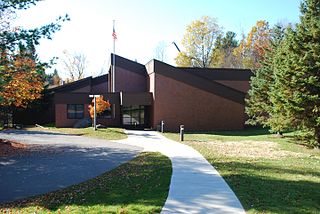
The Michigan Iron Industry Museum, a branch facility of the Michigan Historical Center, is a community museum serving the heritage of the Marquette Iron Range on Michigan's Upper Peninsula. The museum is located in Negaunee, a town built atop the geological strata of the iron range near Marquette. Until recently, Negaunee was a one-industry town that centered on the mining of iron ore. The Negaunee region served as the center of U.S. iron ore production from about 1880 until approximately 1900, when this role was taken over by iron mines on Minnesota's Mesabi Iron Range. The Michigan Iron Industry Museum opened in 1987 close to the Carp River Forge site on the Carp River where Michigan iron ore was first forged in 1848.




